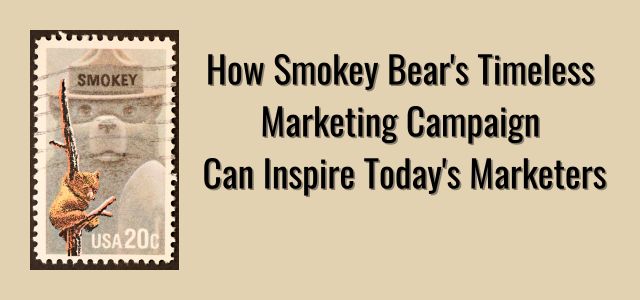When I first saw Smokey Bear at the Washington National Zoo back in 1960, he was already ten years old and well-known to kids everywhere as the symbol of the U.S. Forest Service’s Fire Prevention campaign.
The story of his life along with the evolution of the “Prevent Forest Fires” campaign featuring Smokey is an interesting one.
During World War II, the U.S. Forest Service became concerned about the Japanese starting forest fires on the west coast. Early forest-fire prevention slogans were more directly war-related, including “Forest Fires Aid the Enemy: Use an ash tray” and “Our Carelessness: Their Secret Weapon: Prevent Forest Fires”
But in August of 1942, the movie Bambi came out. The movie became an instant hit. Disney let the Forest Service borrow their forest-dwelling star for a year. Bambi’s campaign was so successful that the Forest Ervice realized it needed to create their own friendly-appearing animal for their fire-prevention cause.
Enter Smokey.
 They created a fictional bear as a symbol for the campaign. Artist Albert Staehle created the original “Smokey Bear” on a poster, showing him with a shovel and a bucket, urging people to prevent forest fires.
They created a fictional bear as a symbol for the campaign. Artist Albert Staehle created the original “Smokey Bear” on a poster, showing him with a shovel and a bucket, urging people to prevent forest fires.
However, it was in 1950 that Smokey Bear’s story took a more personal and heartfelt turn. In the Capitan Mountains of New Mexico, a devastating forest fire broke out. Among the charred remains, a bear cub was found clinging to a tree, badly burned and frightened. The firefighters rescued the cub and named him “Hotfoot” due to the burns on his paws and legs.
Hotfoot quickly became a national sensation as his story spread through the media. The public was captivated by this brave and resilient bear who had survived a devastating fire. The U.S. Forest Service saw an opportunity to associate their fire prevention campaign with Hotfoot, who was then renamed “Smokey Bear” in honor of the original poster character. Smokey became the living embodiment of the Forest Service’s message: “Only YOU can prevent forest fires.”
Smokey Bear’s popularity soared, and he became a beloved figure, particularly among children. His image was used in numerous advertising campaigns, featuring him in various poses and scenarios, always emphasizing the importance of fire prevention. Smokey’s friendly and approachable demeanor, coupled with his catchy slogan, made him an effective marketing tool in educating the public about the dangers of wildfires and the responsibility each individual has in preventing them.
Over the years, Smokey Bear’s image appeared on posters, billboards, television commercials, and other media outlets. His marketing campaigns often featured memorable phrases like “Remember… only YOU can prevent forest fires” and “Get your Smokey on.” These campaigns aimed to instill a sense of personal responsibility and empower individuals to take action in protecting forests and preventing wildfires.
Smokey Bear’s influence extended beyond marketing campaigns. He became a cultural icon, inspiring songs, books, cartoons, and even a comic strip. His friendly face and important message became synonymous with fire prevention efforts across the United States.
Although the real Smokey Bear passed away in 1976, his legacy lives on. The U.S. Forest Service continues to use his image and message in ongoing fire prevention campaigns. Smokey Bear serves as a reminder of the power of captivating storytelling, emotional appeal, and the ability to connect with audiences on a personal level.
The story of Smokey Bear showcases the tremendous impact that a symbol or character with emotional appeal can have on marketing campaigns. By capturing the audience’s imagination and evoking their emotions, businesses can create powerful messages that resonate with their target market. Just as Smokey Bear has left an indelible mark on fire prevention efforts, finding a unique and emotionally resonant symbol can greatly enhance the effectiveness of any marketing strategy.

